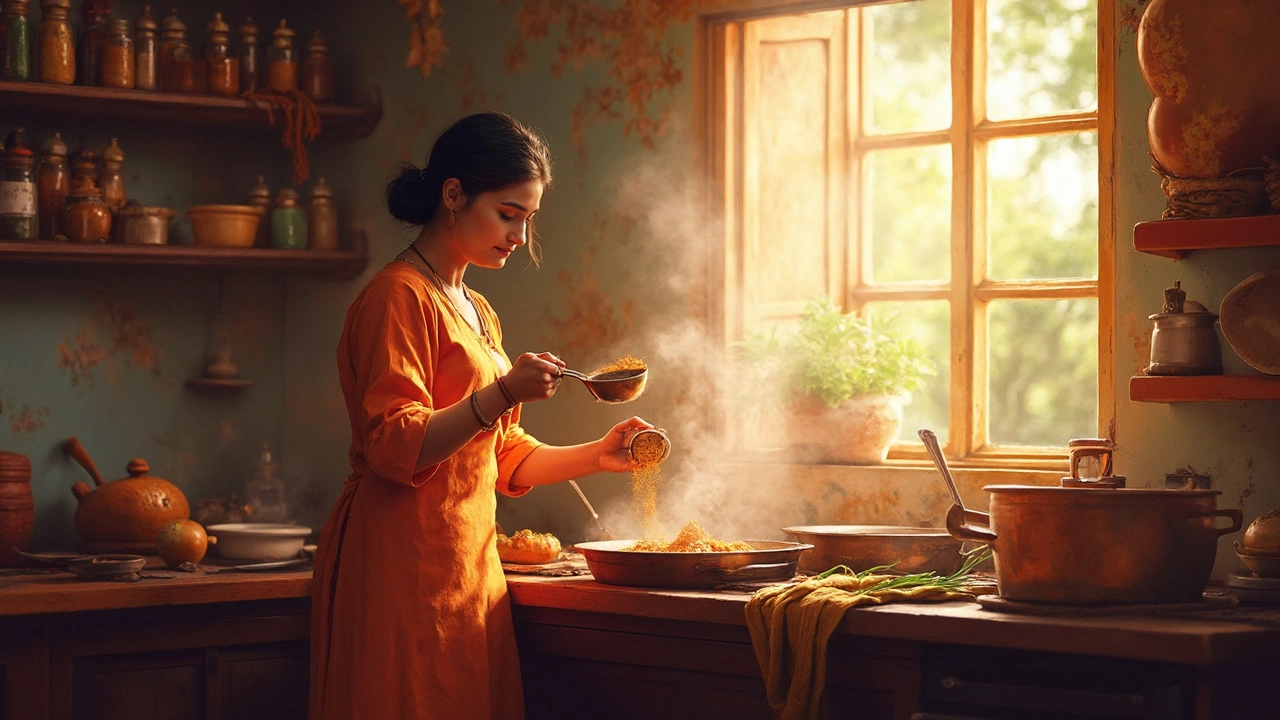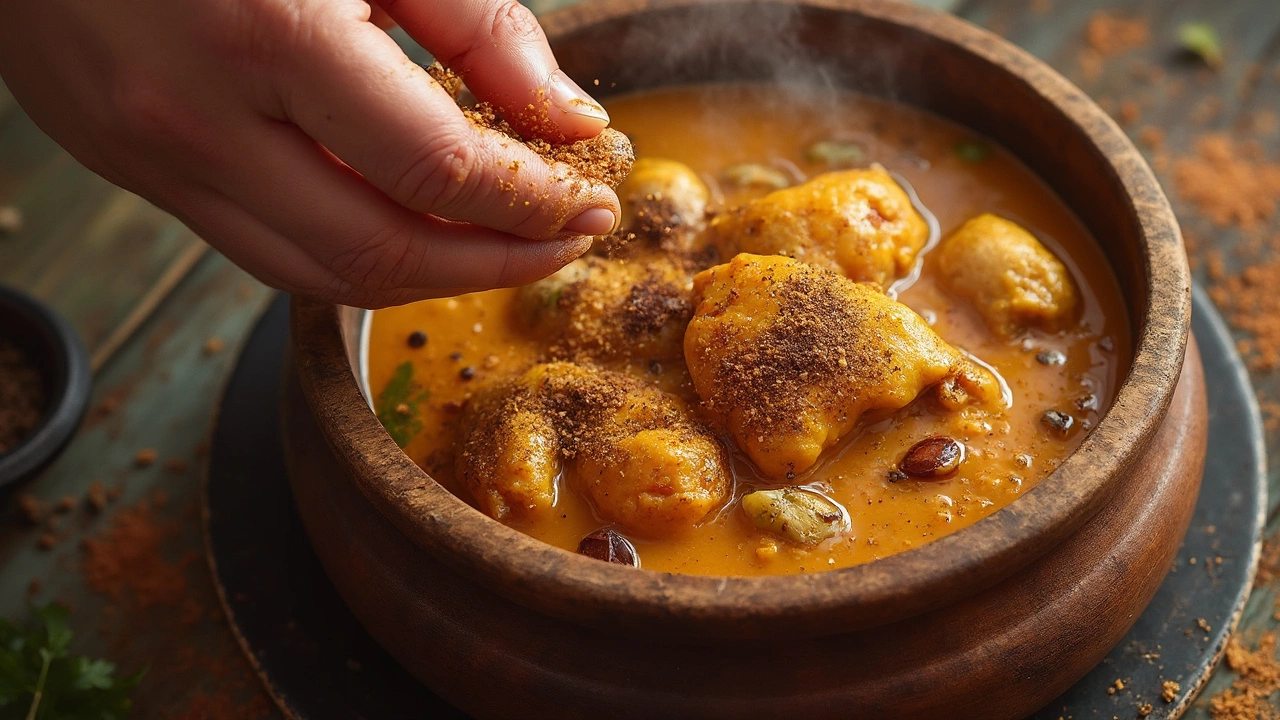Popular Curry Spice: The Role of Garam Masala in Chicken Curry Recipes
 Apr, 28 2025
Apr, 28 2025
Ever wondered what makes chicken curry taste the way it does? The answer is usually a handful of spices, but garam masala is the big one. This blend isn’t just typical curry powder—it’s like adding a soundtrack to your meal that makes everything pop.
There’s a reason cooks reach for garam masala instead of tossing in just any spice mix. Its mix of cinnamon, cloves, cardamom, and a few other hits bring a warmth and depth that single spices just can’t pull off. Even with just a small pinch, the aroma takes over your kitchen and gives your curry real personality.
If you’re aiming for chicken curry that tastes like something you’d get in a real Indian kitchen, this is your go-to ingredient. You don’t need a cabinet full of different powders—just knowing how and when to use garam masala goes a long way. Stick around to see what actually goes in it, how not to mess up the timing, and why store-bought is sometimes just as good as homemade if you pick the right brand.
- Spotlight on Garam Masala
- Building Blocks: What’s in the Spice?
- How to Use Garam Masala the Right Way
- Switch-Ups and Kitchen Tips
Spotlight on Garam Masala
If you talk about curry spice anywhere—especially in the context of a classic chicken curry—garam masala is always front and center. Forget what you see in random "curry powder" jars at the grocery store. Garam masala has a vibe of its own and is at the heart of countless North Indian-style recipes. It’s not even a single spice. Instead, it’s a custom mix, and every family, every chef, puts their own spin on it—kind of like how people tweak their barbecue rubs.
What makes garam masala stand out? Well, it’s all about balance. You’ll taste a bit of sweetness from cinnamon, some heat from black pepper, earthiness from cumin, and a hint of floral thanks to cardamom. Sometimes you’ll get nutmeg, bay leaf, or even star anise thrown in. The goal is to create a warm, layered flavor that hits you right away but never overpowers the chicken.
Garam masala isn’t just sprinkled in at the start. The real pro move is adding it towards the end of cooking your chicken curry. That way, your dish doesn’t lose those bold flavors during a long simmer; they stay punchy and fresh up until serving.
Here’s something you might not know: the word "garam" means "hot," but it’s not just about spicy heat. It refers to the warming qualities of the spices, which, according to traditional Indian medicine, are meant to warm your body from the inside out.
To show you how vital this Indian spice is in real kitchens, check out this snapshot from a popular spice database comparing frequency of use:
| Spice | % of Chicken Curry Recipes Listed |
|---|---|
| Garam Masala | 88% |
| Curry Powder | 52% |
| Turmeric | 76% |
So when you’re on the hunt for that signature taste in a chicken curry recipe, garam masala isn’t just a sidekick—it’s the main act for flavor depth and aroma.
Building Blocks: What’s in the Spice?
So, what exactly goes into garam masala? It’s not just one thing but a team of spices. If you open up a decent brand of curry spice, you’ll spot some familiar names—and probably a few you’ve seen gathering dust in the pantry.
- Cinnamon: Adds a sweet, woody warmth. It’s what makes your chicken curry smell rich and inviting.
- Cloves: Just a few of these go a long way. Think strong and slightly sweet, giving a bit of edge to the mix.
- Cardamom: This gives the blend that kind of fresh, almost menthol kick. Most blends use green cardamom pods.
- Coriander: A favorite in most Indian spices, it makes the flavor rounder and fuller. Some home cooks add more, especially for chicken recipes.
- Cumin: No curry is complete without this. It brings an earthy, slightly nutty note that matches chicken perfectly.
- Black Pepper: Adds real heat without making things super spicy. Cayenne is rarely a mainstay here; pepper tends to be enough in a basic curry spice mix.
- Nutmeg and mace: Not every mix has these, but they’re like the supporting actors—subtle, but you miss them if they’re left out.
The best part? Every household or spice company has its own recipe. Some throw in bay leaves, star anise, or even dried chilies. That’s why two chicken curries almost never taste exactly the same.
If you’re looking at pre-made mixes, check the label. Brands will often list the main spices right on the front. Watch for plain “curry powder” though—it’s not the same as genuine garam masala and usually swaps out key flavors for turmeric. That’s not what you want for classic chicken curry.
| Common Garam Masala Ingredients | Flavor It Adds |
|---|---|
| Cinnamon | Warm, sweet |
| Cloves | Pungent, strong |
| Cardamom | Fresh, herbal |
| Coriander | Nuttiness, citrus |
| Cumin | Earthy, savory |
| Black Pepper | Heat, sharpness |
Bottom line: You’ll get the best chicken curry flavor when you use a blend that pulls its weight. Don’t be afraid to experiment a little—or even build your own blend at home by mixing and matching from this list.

How to Use Garam Masala the Right Way
First things first: garam masala isn’t like regular spice powders that need plenty of time to cook. This blend packs most of its punch from aroma, not just heat. The trick is that you don’t just toss it in early and forget about it. In most chicken curry recipes, you sprinkle garam masala near the end of cooking, sometimes even after switching off the stove. This way, you keep every bit of that warm, sweet smell and the flavors stay bold.
If you add it too early, the spices can get bitter or just lose what makes them special. For dishes with gravy—like butter chicken or classic chicken curry—wait until the sauce is ready, then stir in the garam masala and let it sit for a minute. That’s when you’ll smell the difference in your kitchen.
- Start with a teaspoon for a family-sized curry, then taste and add more if you want it stronger. Garam masala is strong, so you rarely need more than two teaspoons for one dish.
- For a brighter flavor, sprinkle a little as a finishing touch after cooking.
- If you’re new to it, mix garam masala with a bit of water before adding, so it spreads better through the curry.
Some cooks like to add a pinch of garam masala to their marinade before cooking the chicken. This gives the meat a subtle boost. But if you’re worried about overpowering the dish, just stick to the method above.
Check out this quick table for typical spice timings in a standard curry recipe:
| Spice | When to Add |
|---|---|
| Turmeric & Chile Powder | Early, when frying onions |
| Coriander & Cumin | With ginger and garlic |
| Garam Masala | End or after cooking |
One last thing: heat can kill the best qualities of garam masala, so don’t cook it too long or on high heat. Use it wisely, and you’ll always get the best curry flavor.
Switch-Ups and Kitchen Tips
So, you’re staring at your spice rack wondering if you really need to use garam masala every time. Good news—there’s room for creativity, but a few ground rules will save your curry from turning bland or weirdly sweet. If you run out of garam masala, try mixing ground cumin, coriander, and a tiny bit of cinnamon as a quick substitute. It won’t be exactly the same, but it keeps the heart of the curry spice vibe alive.
Want a smokier flavor? Add a pinch of smoked paprika along with the garam masala, but go easy or you’ll overpower everything. If you’re making your own blend, toasting whole spices first unlocks deeper flavors. Just toss them in a dry pan for a couple minutes until they’re fragrant, then grind them up. That’s how restaurants get those punchy flavors.
Store-bought garam masala is actually fine for weeknight dinners, especially if you like predictable results. But brands vary a lot. Some are heavy on clove, some put too much black pepper. If you care about the exact taste, check the ingredient order on the label. The closer cinnamon, cardamom, and cumin are to the top, the milder and smoother your curry turns out. And remember, garam masala goes in at the end of cooking—not the start. That keeps the flavors bright instead of cooked away.
- Always taste before adding extra spice. Garam masala is strong stuff—you can always add more but taking it out is impossible.
- If you want your chicken curry thick, switch half your tomatoes out for Greek yogurt or coconut cream. The creaminess balances the heat and makes the flavor sing.
- Batch-cook the spice mix and store it in an airtight jar. Just keep it out of the sun so the flavors last.
- Experiment with other Indian spice blends like tandoori masala for a different twist, but always try them with a test batch first.
Here’s a quick look at how different homemade garam masala blends change up the curry:
| Spice Focus | Flavor Profile | Best For |
|---|---|---|
| Cinnamon & Cardamom | Smooth, mild | Kids, milder palates |
| Clove & Pepper | Peppery punch | Spicy, robust dishes |
| Cumin & Fennel | Earthy, sweet | Lighter, fresh curries |
The more you play around, the more you’ll see that the "best" curry spice for your chicken curry isn’t always the usual one. Tweak it to match how you actually like it. No judgment here.
